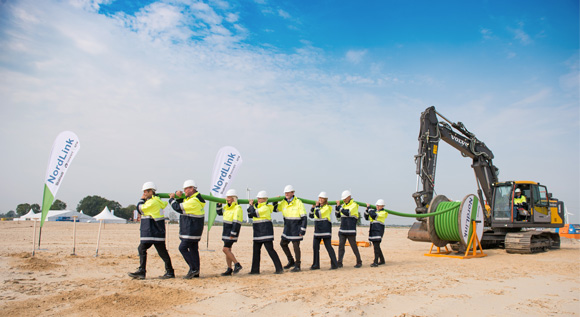Well connected
The distance between Germany and Norway is becoming smaller! As part of the NordLink project, 600 kilometres of submarine cable will join up both countries’ electricity markets. The first spade has already been dug.
 Digging of first spade and symbolic unwinding of cable for NordLink. © TenneT
Digging of first spade and symbolic unwinding of cable for NordLink. © TenneT
The town of Wilster in Schleswig-Holstein, Germany, close to the mouth of the River Elbe. In this town of 4,000 residents, digging work has now begun to bring the electricity markets in north-west Europe a good deal closer together.
This is the NordLink project, which involves the laying of a 623-kilometre-long submarine cable metre for metre, moving towards the village of Tonstad in southern Norway. Some 516 kilometres of this will run under the seafloor. The aim is to link up the electricity markets of Germany and Norway by 2020 at the latest.
Greater energy security, stabler prices
The NordLink project has been launched in order to ensure that the supply of electricity from renewable sources is secure. The new submarine cable will enable hydropower from Norway to be exchanged for wind and solar energy from Germany. This can be useful at times when Germany produces more wind power than it consumes, for example. This surplus power can be transported directly to Norway where it will be used straight away, where it will replace the use of hydropower for a particular length of time. And, conversely, at times when the energy demand in Germany is high, electricity from Norwegian water storage facilities can be transported to Germany. What this means is that security of supply in Germany will increase and that consumers will benefit, not least of all from electricity prices that are stable.
High-voltage direct current transmission over 623 kilometres
The NordLink project is putting state-of-the-art technology underneath the North Sea. The submarine cable has a transmission capacity of 1,400 megawatts (MW), which is roughly equivalent to the capacity of a nuclear power station. It uses high-voltage direct current transmission technology, or HVDC for short. This is particularly well suited for use over long distances as the level of power lost is lower than when transmitting alternating current, as is standard practice in the German transmission grid. A converter platform located in Wilster will transform the alternating current into direct current and vice versa, while also ensuring that the electricity transported from the North is fed into the German electricity grid. HVDC transmission lines are also used to connect offshore wind farms. They are virtually maintenance-free.
The NordLink project is being realised by a consortium between Norwegian transmission system operator (TSO) Statnett and Germany’s DC Nordseekabel GmbH & Co. KG, each of which own a 50% stake in the project. The German limited company is owned by TSO TenneT and by the KfW, which each hold an equal stake.

